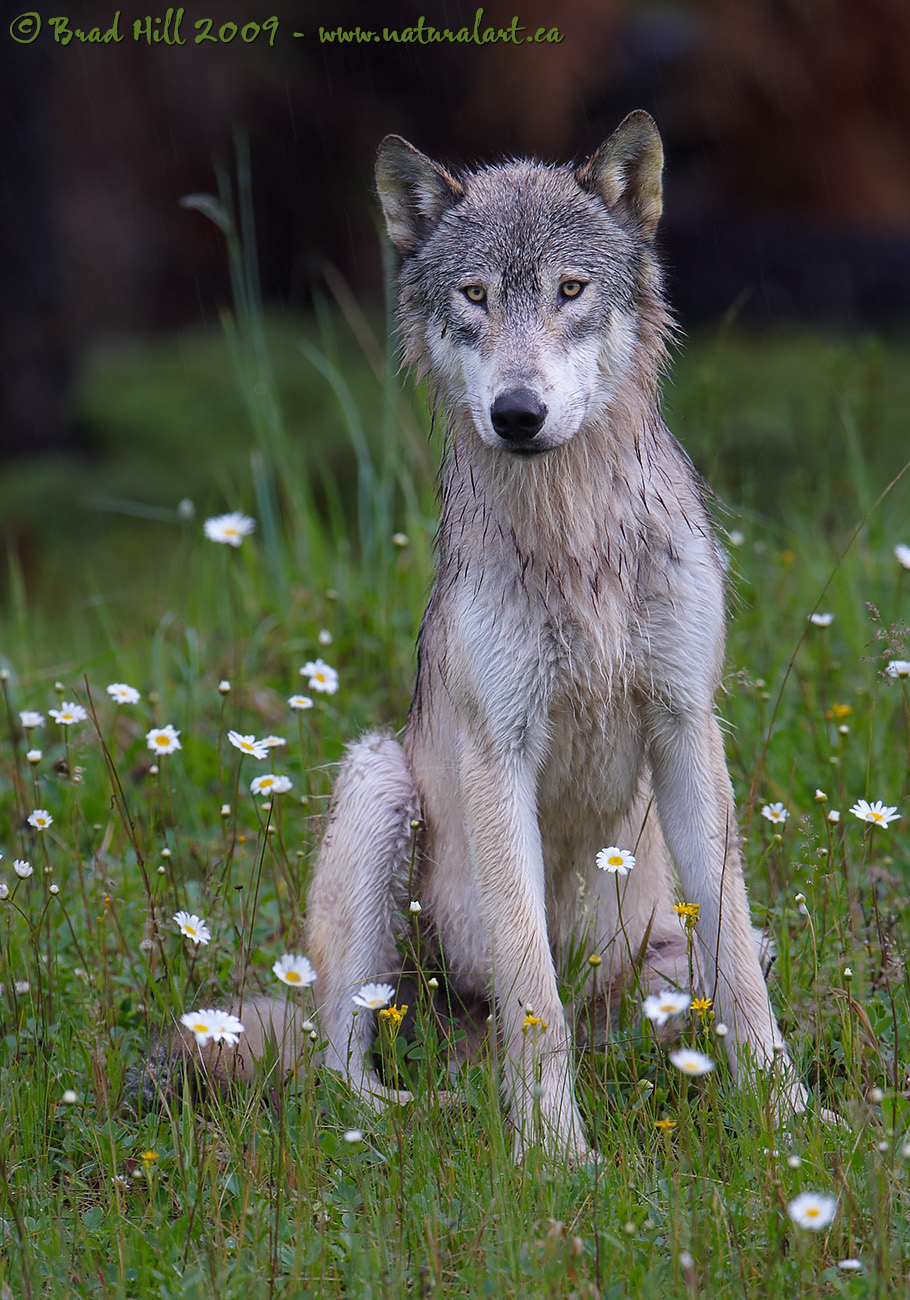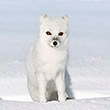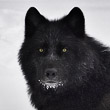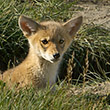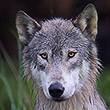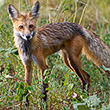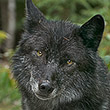Availability: Undetermined - Enquiries?
In the Field
Gray Wolf, White Daisies. Rocky Mountains, southern BC, Canada. July 10, 2009.
It's funny how some things turn out. In June of 2009 I had my first major malfunction of piece of professional Nikon equipment - the focusing system on my normally trusty 200-400 mm VR lens died. Fortunately it was covered by warranty (just), but because I live in a very rural area I had to drive my lens to the nearest major city (Calgary, AB) to have it sent in by my Nikon dealer. In early July I got the word the lens was fixed (no charge - thanks Nikon Canada) and waiting for pickup. Because I wanted to test the lens before I took it out of the shop, I had to drive over 300 km to pick it up. Begrudgingly I left very early on the morning of July 10 to get my lens - and I admit I was quite choked about having to waste the better part of a day to go pick up a piece of gear that shouldn't have malfunctioned in the first place. But...long story short(er) - less than 50 km from home I turned a corner on the road and almost ran into this wolf! One half hour and 50 images or so later, I was real glad my 200-400 lens had needed repair and I was forced to make this trip!
This is one of those images to which I have an emotional attachment. It's not a great wolf shot or even a "typical" wolf shot (if any such thing exists). But the casualness of the pose and the relaxed manner of the wolf that it conveys brings back great memories - so I'll always look on this shot with fondness.
When I first encountered the wolf it was on the highway. The skies were 100% overcast and it was lightly raining. The wolf slowly walked (not ran) off the highway and on to the road allowance. I assumed that when I stopped the car it would run off. But it didn't - it just very slowly walked into the forest and looked back several times while doing so. I had my Nikon D3 and 600 mm VR sitting in the passenger's seat (no tripod in the car - idiot!) so I grabbed it and decided to follow the wolf - thinking that if I was lucky I MIGHT get a shot of the wolf walking off into the distance. It turned out that just beyond the row of trees along the highway there was a grassy meadow filled with wildflowers. To my surprise, when I entered the meadow the wolf was standing there just looking at me. And it was no more than 30 meters away. I walked a few meters ahead and the wolf didn't flinch. I stopped and knelt down - expecting the wolf to bolt off any second. Instead, it sat down and looked at me. Initially it sat very upright and was obviously alert. It soon relaxed and slumped into a more casual (and comfortable?) slouch - more or less the way my dogs sit when they're relaxed - on one hip with the legs off to the side. That's when I shot this image. A few minutes later it laid down - watching me but clearly very relaxed. So I sat down (I was now about 20 to 25 meters from the wolf). And we stayed like this for 10 to 15 minutes - wolf laying down resting, me sitting (and shooting the odd picture). A few times the wolf laid it's head right down as if to sleep, but I don't think it every nodded right off. I had the feeling that I could have moved in much closer to the wolf, but saw no point in doing so - I had no desire to push the wolf - whatever it gave me was fine with me. Sometimes it's about more than the image. Eventually I slowly stood up and walked back to my truck. On my final glance back the wolf was still laying in the same place, and now not even watching me!
The thing that was so amazing about this interaction was how the wolf tolerated/accepted me at such a close distance. Wolves are not uncommon in my neck of the woods, but seeing them is. They have been persecuted and slaughtered for over 100 years - those that remain tend to be exceptionally wary of humans. This wolf was NOT in a national or provincial park. In fact, in the location where I photographed this one wolves may be hunted 12 months a year, and ANY hunter can shoot them - no "wolf tag" is required. Plus, there are active wolf traplines in the area. Yet for some reason this wolf clearly saw me as no threat whatsoever, and allowed me the privilege of sharing its life for a brief period of time. I will never forget this wolf and what it gave me.
From a photographic perspective my biggest challenge in capturing this image was finding a way to hand-hold my 600 mm lens still enough to get a sharp shot. Being an idiot, I forgot to throw my tripod in the car that morning (I wasn't going shooting and just threw in my camera and huge lens in "just in case"). I don't like sounding like a "hack" for Nikon (or any other manufacturer), but I can honestly say that without a good VR (vibration reduction) system on my lens, I would NEVER have been able to hand-hold my 11 lb 600 mm lens at this slow of a shutter speed.
Behind the Camera
Gray Wolf, White Daisies. Rocky Mountains, southern BC, Canada. July 10, 2009.
Digital Capture; Compressed RAW (NEF) 14-bit format; ISO 400.
Nikon D3 with AF-S Nikkor 600mm f/4G IF-ED II VR lens - handheld. VR turned to "On" and in "Normal" mode.
1/125s @ f5; -0.67 stop compensation from matrix-metered exposure setting of camera (to avoid blowing out the white-on-white detail on the Ox-Eye Daisies).
At the Computer
Gray Wolf, White Daisies. Rocky Mountains, southern BC, Canada. July 10, 2009.
RAW Conversion to 16-bit TIFF, including first-pass/capture sharpening using Phase One's Capture One Pro 4.8. Three RAW conversions at different exposure settings. 3 exposure conversions ranging from -0.25 stops (to retrieve white-on-white detail on the daisies) through to +0.33 stops (to assist in recovery of shadow detail and balance lighting on various parts of the wolf).
Further digital corrections on 16-bit TIFF file using Adobe's Photoshop CS4. Adjustments included compositing and masking of 3 exposure versions, selective colour saturation and desaturation, and selective sharpening for web output.
Conservation
Gray Wolf, White Daisies. Rocky Mountains, southern BC, Canada. July 10, 2009.
Ten percent of the revenue generated by this image will be donated to Wildsight.
Species Status in Canada*: Only Eastern Wolf listed as species of "Special Concern" in May, 2001. Other populations not listed as Endangered or Threatened.
Species Status in the United States: Western Great Lakes population removed from list of Endangered and Threatened species on January 29, 2007. Proposed delisting of Northern Rockies population on January 29, 2007. Both actions are a direct result of a successful recovery plan. Congratulations! Wolves in other areas of the lower 48 states (including the Southwest wolf population), remain on Endangered Species list.
Probably no species alive today has suffered as much direct persecution from humans as has the Gray Wolf (Canis lupus). Once extremely widespread in North America, the Gray Wolf was virtually extirpated from the contiguous 48 states of America and now is regularly found within only a fraction of its historical range in Canada. While the Gray Wolf is currently listed as endangered in most of the 48 lower states of the United States and enjoys the privileges associated with such status (if lack of persecution and abuse can be thought of as a privilege), it is still official policy in much of Canada to rid the countryside of this magnificent keystone predator. As an example, in British Columbia, there is NO closed season on the wolf in most hunting jurisdictions and opportunistic slaughter is encouraged by policy (it is the ONLY fur-bearing species for which NO hunting license is required in British Columbia!). Conservation of wolves presents a puzzling paradox. Reduced to the most basic principles, wolf conservation is simplistic: we need only to stop persecuting this species in order for it to survive. Yet accomplishing this invariably proves incredibly difficult - it's as though wolf persecution has been institutionalized directly into government (and societal) bureaucracy.
I commend and support those individuals and groups that have the patience and determination to fight for the Gray Wolf. This wolf was photographed in the Columbia Valley of southeast British Columbia. Wildsight is an effective conservation organization that protects biodiversity and promotes sustainable communities in Canada's Columbia and Rocky Mountains. Support for Wildsight, through donation or becoming a member, will help ensure that they remain effective in their efforts to conserve threatened or endangered species and ecosystems.
*as determined by COSEWIC: The Committee on the Status of Endangered Wildlife in Canada












